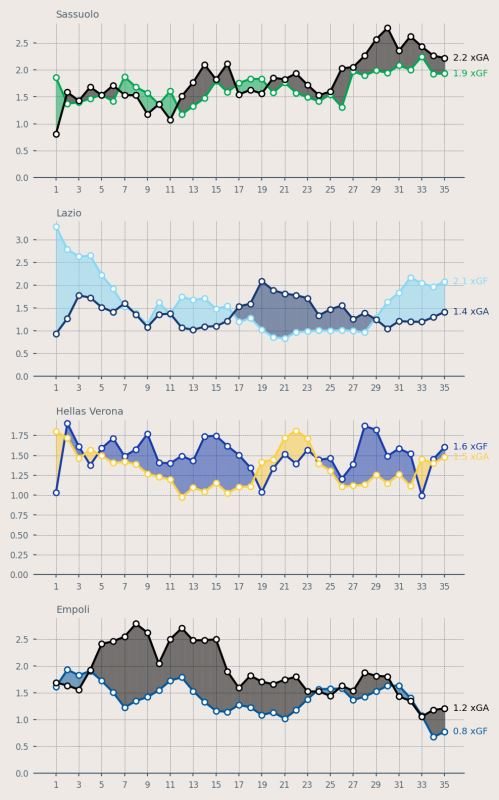1. 導入包 import pandas as pd import matplotlib.pyplot as plt import matplotlib.ticker as ticker import matplotlib.gridspec as gridspec 2. 獲得數據 file_id = ...
1. 導入包
import pandas as pd import matplotlib.pyplot as plt import matplotlib.ticker as ticker import matplotlib.gridspec as gridspec
2. 獲得數據
file_id = '1yM_F93NY4QkxjlKL3GzdcCQEnBiA2ltB'‘Python學習交流群:748989764 ’ url = f'https://drive.google.com/uc?id={file_id}' df = pd.read_csv(url, index_col=0) df
數據長得是這樣的:
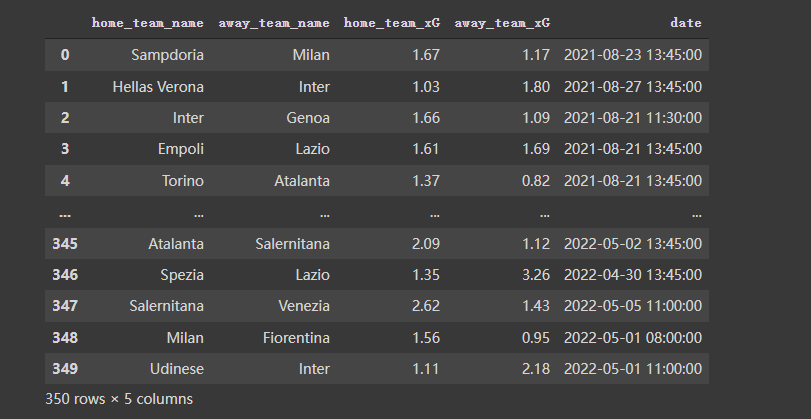
3. 對數據做一些預處理
按照需要,對數據再做一些預處理,代碼及效果如下:
home_df = df.copy() home_df = home_df.melt(id_vars = ["date", "home_team_name", "away_team_name"]) home_df["venue"] = "H" home_df.rename(columns = {"home_team_name":"team", "away_team_name":"opponent"}, inplace = True) home_df.replace({"variable":{"home_team_xG":"xG_for", "away_team_xG":"xG_ag"}}, inplace = True)
away_df = df.copy() away_df = away_df.melt(id_vars = ["date", "away_team_name", "home_team_name"]) away_df["venue"] = "A" away_df.rename(columns = {"away_team_name":"team", "home_team_name":"opponent"}, inplace = True) away_df.replace({"variable":{"away_team_xG":"xG_for", "home_team_xG":"xG_ag"}}, inplace = True)
df = pd.concat([home_df, away_df]).reset_index(drop = True)
df
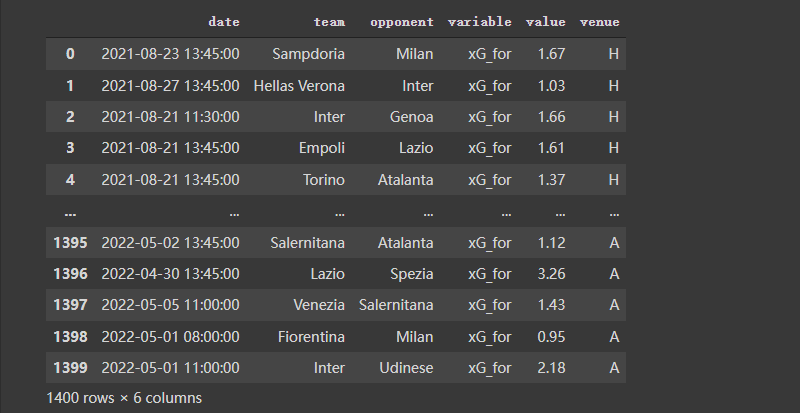
4. 畫圖
# ---- Filter the data Y_for = df[(df["team"] == "Lazio") & (df["variable"] == "xG_for")]["value"].reset_index(drop = True) Y_ag = df[(df["team"] == "Lazio") & (df["variable"] == "xG_ag")]["value"].reset_index(drop = True) X_ = pd.Series(range(len(Y_for))) # ---- Compute rolling average Y_for = Y_for.rolling(window = 5, min_periods = 0).mean() # min_periods is for partial avg. Y_ag = Y_ag.rolling(window = 5, min_periods = 0).mean()
fig, ax = plt.subplots(figsize = (7,3), dpi = 200)
ax.plot(X_, Y_for)
ax.plot(X_, Y_ag)
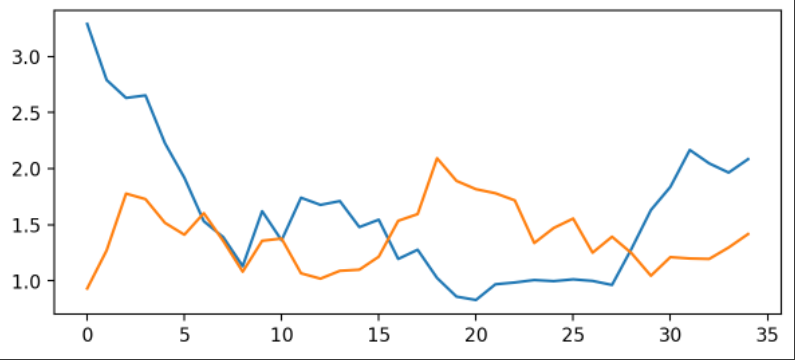
使用matplotlib倒是可以快速把圖畫好了,但是太醜了。接下來進行優化。
4.1 優化:添加點
這裡為每一個數據添加點
fig, ax = plt.subplots(figsize = (7,3), dpi = 200) # --- Remove spines and add gridlines ax.spines["left"].set_visible(False) ax.spines["top"].set_visible(False) ax.spines["right"].set_visible(False) ax.grid(ls = "--", lw = 0.5, color = "#4E616C") # --- The data ax.plot(X_, Y_for, marker = "o") ax.plot(X_, Y_ag, marker = "o")
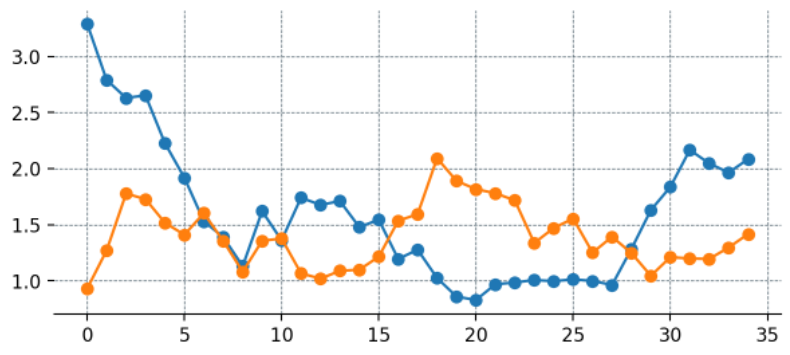
4.2 優化:設置刻度
fig, ax = plt.subplots(figsize = (7,3), dpi = 200) # --- Remove spines and add gridlines ax.spines["left"].set_visible(False) ax.spines["top"].set_visible(False) ax.spines["right"].set_visible(False) ax.grid(ls = "--", lw = 0.25, color = "#4E616C") # --- The data ax.plot(X_, Y_for, marker = "o", mfc = "white", ms = 5) ax.plot(X_, Y_ag, marker = "o", mfc = "white", ms = 5) # --- Adjust tickers and spine to match the style of our grid ax.xaxis.set_major_locator(ticker.MultipleLocator(2)) # ticker every 2 matchdays xticks_ = ax.xaxis.set_ticklabels([x - 1 for x in range(0, len(X_) + 3, 2)]) # This last line outputs # [-1, 1, 3, 5, 7, 9, 11, 13, 15, 17, 19, 21, 23, 25, 27, 29, 31, 33, 35] # and we mark the tickers every two positions. ax.xaxis.set_tick_params(length = 2, color = "#4E616C", labelcolor = "#4E616C", labelsize = 6) ax.yaxis.set_tick_params(length = 2, color = "#4E616C", labelcolor = "#4E616C", labelsize = 6) ax.spines["bottom"].set_edgecolor("#4E616C")
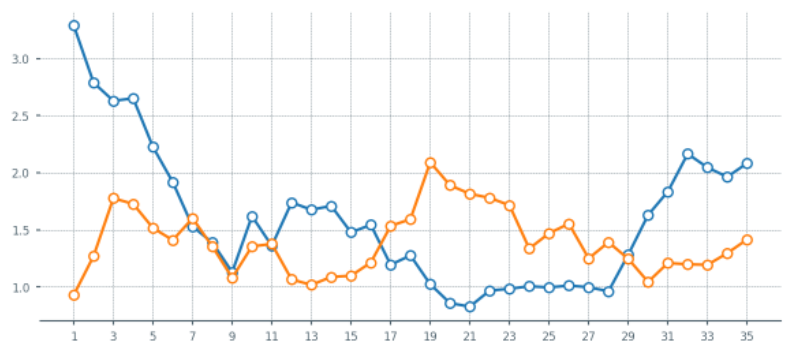
4.3 優化:設置填充
fig, ax = plt.subplots(figsize = (7,3), dpi = 200)
Python學習交流群:748989764
# --- Remove spines and add gridlines ax.spines["left"].set_visible(False) ax.spines["top"].set_visible(False) ax.spines["right"].set_visible(False) ax.grid(ls = "--", lw = 0.25, color = "#4E616C") # --- The data ax.plot(X_, Y_for, marker = "o", mfc = "white", ms = 5) ax.plot(X_, Y_ag, marker = "o", mfc = "white", ms = 5) # --- Fill between ax.fill_between(x = X_, y1 = Y_for, y2 = Y_ag, alpha = 0.5) # --- Adjust tickers and spine to match the style of our grid ax.xaxis.set_major_locator(ticker.MultipleLocator(2)) # ticker every 2 matchdays xticks_ = ax.xaxis.set_ticklabels([x - 1 for x in range(0, len(X_) + 3, 2)]) ax.xaxis.set_tick_params(length = 2, color = "#4E616C", labelcolor = "#4E616C", labelsize = 6) ax.yaxis.set_tick_params(length = 2, color = "#4E616C", labelcolor = "#4E616C", labelsize = 6) ax.spines["bottom"].set_edgecolor("#4E616C")
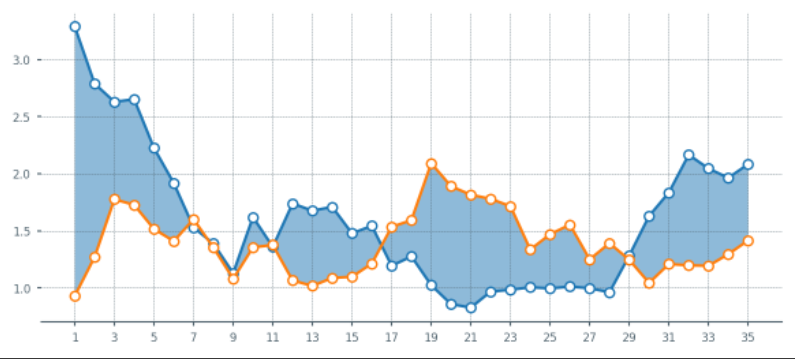
4.4 優化:設置填充顏色
1.當橙色線更高時,希望填充為橙色。但是上面的還無法滿足,這裡再優化一下.
fig, ax = plt.subplots(figsize = (7,3), dpi = 200) # --- Remove spines and add gridlines ax.spines["left"].set_visible(False) ax.spines["top"].set_visible(False) ax.spines["right"].set_visible(False) ax.grid(ls = "--", lw = 0.25, color = "#4E616C") # --- The data ax.plot(X_, Y_for, marker = "o", mfc = "white", ms = 5) ax.plot(X_, Y_ag, marker = "o", mfc = "white", ms = 5) # --- Fill between # Identify points where Y_for > Y_ag pos_for = (Y_for > Y_ag) ax.fill_between(x = X_[pos_for], y1 = Y_for[pos_for], y2 = Y_ag[pos_for], alpha = 0.5) pos_ag = (Y_for <= Y_ag) ax.fill_between(x = X_[pos_ag], y1 = Y_for[pos_ag], y2 = Y_ag[pos_ag], alpha = 0.5) # --- Adjust tickers and spine to match the style of our grid ax.xaxis.set_major_locator(ticker.MultipleLocator(2)) # ticker every 2 matchdays xticks_ = ax.xaxis.set_ticklabels([x - 1 for x in range(0, len(X_) + 3, 2)]) ax.xaxis.set_tick_params(length = 2, color = "#4E616C", labelcolor = "#4E616C", labelsize = 6) ax.yaxis.set_tick_params(length = 2, color = "#4E616C", labelcolor = "#4E616C", labelsize = 6) ax.spines["bottom"].set_edgecolor("#4E616C")
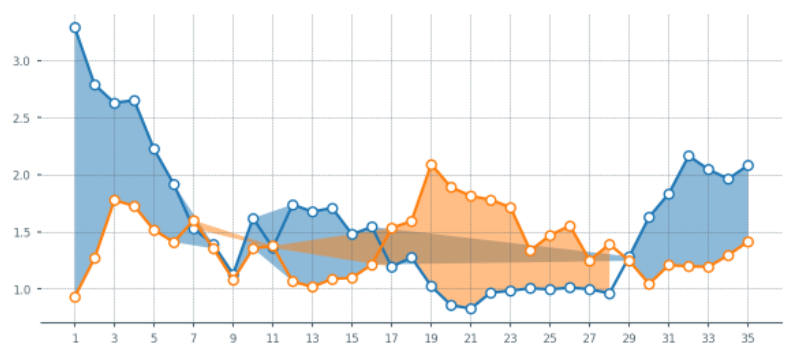
上面的圖出現異常,再修改一下:
X_aux = X_.copy() X_aux.index = X_aux.index * 10 # 9 aux points in between each match last_idx = X_aux.index[-1] + 1 X_aux = X_aux.reindex(range(last_idx)) X_aux = X_aux.interpolate() # --- Aux series for the xG created (Y_for) Y_for_aux = Y_for.copy() Y_for_aux.index = Y_for_aux.index * 10 last_idx = Y_for_aux.index[-1] + 1 Y_for_aux = Y_for_aux.reindex(range(last_idx)) Y_for_aux = Y_for_aux.interpolate() # --- Aux series for the xG conceded (Y_ag) Y_ag_aux = Y_ag.copy() Y_ag_aux.index = Y_ag_aux.index * 10 last_idx = Y_ag_aux.index[-1] + 1 Y_ag_aux = Y_ag_aux.reindex(range(last_idx)) Y_ag_aux = Y_ag_aux.interpolate() fig, ax = plt.subplots(figsize = (7,3), dpi = 200) # --- Remove spines and add gridlines ax.spines["left"].set_visible(False) ax.spines["top"].set_visible(False) ax.spines["right"].set_visible(False) ax.grid(ls = "--", lw = 0.25, color = "#4E616C") # --- The data for_ = ax.plot(X_, Y_for, marker = "o", mfc = "white", ms = 5) ag_ = ax.plot(X_, Y_ag, marker = "o", mfc = "white", ms = 5) # --- Fill between for index in range(len(X_aux) - 1): # Choose color based on which line's on top if Y_for_aux.iloc[index + 1] > Y_ag_aux.iloc[index + 1]: color = for_[0].get_color() else: color = ag_[0].get_color() # Fill between the current point and the next point in pur extended series. ax.fill_between([X_aux[index], X_aux[index+1]], [Y_for_aux.iloc[index], Y_for_aux.iloc[index+1]], [Y_ag_aux.iloc[index], Y_ag_aux.iloc[index+1]], color=color, zorder = 2, alpha = 0.2, ec = None) # --- Adjust tickers and spine to match the style of our grid ax.xaxis.set_major_locator(ticker.MultipleLocator(2)) # ticker every 2 matchdays xticks_ = ax.xaxis.set_ticklabels([x - 1 for x in range(0, len(X_) + 3, 2)]) ax.xaxis.set_tick_params(length = 2, color = "#4E616C", labelcolor = "#4E616C", labelsize = 6) ax.yaxis.set_tick_params(length = 2, color = "#4E616C", labelcolor = "#4E616C", labelsize = 6) ax.spines["bottom"].set_edgecolor("#4E616C")
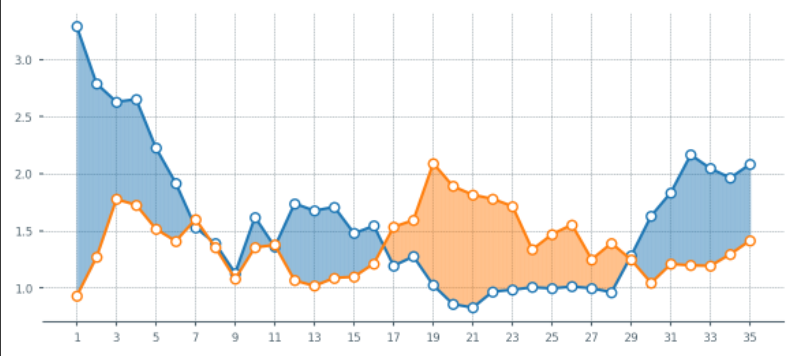
5. 把功能打包成函數
上面的樣子都還不錯啦,接下來把這些東西都打包成一個函數。方便後面直接出圖。
def plot_xG_rolling(team, ax, window = 5, color_for = "blue", color_ag = "orange", data = df): ''' This function creates a rolling average xG plot for a given team and rolling window. team (str): The team's name ax (obj): a Matplotlib axes. window (int): The number of periods for our rolling average. color_for (str): A hex color code for xG created. color_af (str): A hex color code for xG conceded. data (DataFrame): our df with the xG data. ''' # -- Prepping the data home_df = data.copy() home_df = home_df.melt(id_vars = ["date", "home_team_name", "away_team_name"]) home_df["venue"] = "H" home_df.rename(columns = {"home_team_name":"team", "away_team_name":"opponent"}, inplace = True) home_df.replace({"variable":{"home_team_xG":"xG_for", "away_team_xG":"xG_ag"}}, inplace = True) away_df = data.copy() away_df = away_df.melt(id_vars = ["date", "away_team_name", "home_team_name"]) away_df["venue"] = "A" away_df.rename(columns = {"away_team_name":"team", "home_team_name":"opponent"}, inplace = True) away_df.replace({"variable":{"away_team_xG":"xG_for", "home_team_xG":"xG_ag"}}, inplace = True) df = pd.concat([home_df, away_df]).reset_index(drop = True) # ---- Filter the data Y_for = df[(df["team"] == team) & (df["variable"] == "xG_for")]["value"].reset_index(drop = True) Y_ag = df[(df["team"] == team) & (df["variable"] == "xG_ag")]["value"].reset_index(drop = True) X_ = pd.Series(range(len(Y_for))) if Y_for.shape[0] == 0: raise ValueError(f"Team {team} is not present in the DataFrame") # ---- Compute rolling average Y_for = Y_for.rolling(window = 5, min_periods = 0).mean() # min_periods is for partial avg. Y_ag = Y_ag.rolling(window = 5, min_periods = 0).mean() # ---- Create auxiliary series for filling between curves X_aux = X_.copy() X_aux.index = X_aux.index * 10 # 9 aux points in between each match last_idx = X_aux.index[-1] + 1 X_aux = X_aux.reindex(range(last_idx)) X_aux = X_aux.interpolate() # --- Aux series for the xG created (Y_for) Y_for_aux = Y_for.copy() Y_for_aux.index = Y_for_aux.index * 10 last_idx = Y_for_aux.index[-1] + 1 Y_for_aux = Y_for_aux.reindex(range(last_idx)) Y_for_aux = Y_for_aux.interpolate() # --- Aux series for the xG conceded (Y_ag) Y_ag_aux = Y_ag.copy() Y_ag_aux.index = Y_ag_aux.index * 10 last_idx = Y_ag_aux.index[-1] + 1 Y_ag_aux = Y_ag_aux.reindex(range(last_idx)) Y_ag_aux = Y_ag_aux.interpolate() # --- Plotting our data # --- Remove spines and add gridlines ax.spines["left"].set_visible(False) ax.spines["top"].set_visible(False) ax.spines["right"].set_visible(False) ax.grid(ls = "--", lw = 0.25, color = "#4E616C") # --- The data for_ = ax.plot(X_, Y_for, marker = "o", mfc = "white", ms = 4, color = color_for) ag_ = ax.plot(X_, Y_ag, marker = "o", mfc = "white", ms = 4, color = color_ag) # --- Fill between for index in range(len(X_aux) - 1): # Choose color based on which line's on top if Y_for_aux.iloc[index + 1] > Y_ag_aux.iloc[index + 1]: color = for_[0].get_color() else: color = ag_[0].get_color() # Fill between the current point and the next point in pur extended series. ax.fill_between([X_aux[index], X_aux[index+1]], [Y_for_aux.iloc[index], Y_for_aux.iloc[index+1]], [Y_ag_aux.iloc[index], Y_ag_aux.iloc[index+1]], color=color, zorder = 2, alpha = 0.2, ec = None) # --- Ensure minimum value of Y-axis is zero ax.set_ylim(0) # --- Adjust tickers and spine to match the style of our grid ax.xaxis.set_major_locator(ticker.MultipleLocator(2)) # ticker every 2 matchdays xticks_ = ax.xaxis.set_ticklabels([x - 1 for x in range(0, len(X_) + 3, 2)]) ax.xaxis.set_tick_params(length = 2, color = "#4E616C", labelcolor = "#4E616C", labelsize = 6) ax.yaxis.set_tick_params(length = 2, color = "#4E616C", labelcolor = "#4E616C", labelsize = 6) ax.spines["bottom"].set_edgecolor("#4E616C") # --- Legend and team name Y_for_last = Y_for.iloc[-1] Y_ag_last = Y_ag.iloc[-1] # -- Add the team's name team_ = ax.text( x = 0, y = ax.get_ylim()[1] + ax.get_ylim()[1]/20, s = f'{team}', color = "#4E616C", va = 'center', ha = 'left', size = 7 ) # -- Add the xG created label for_label_ = ax.text( x = X_.iloc[-1] + 0.75, y = Y_for_last, s = f'{Y_for_last:,.1f} xGF', color = color_for, va = 'center', ha = 'left', size = 6.5 ) # -- Add the xG conceded label ag_label_ = ax.text( x = X_.iloc[-1] + 0.75, y = Y_ag_last, s = f'{Y_ag_last:,.1f} xGA', color = color_ag, va = 'center', ha = 'left', size = 6.5 )
6.測試函數
file_id = '1yM_F93NY4QkxjlKL3GzdcCQEnBiA2ltB' url = f'https://drive.google.com/uc?id={file_id}' df = pd.read_csv(url, index_col=0)
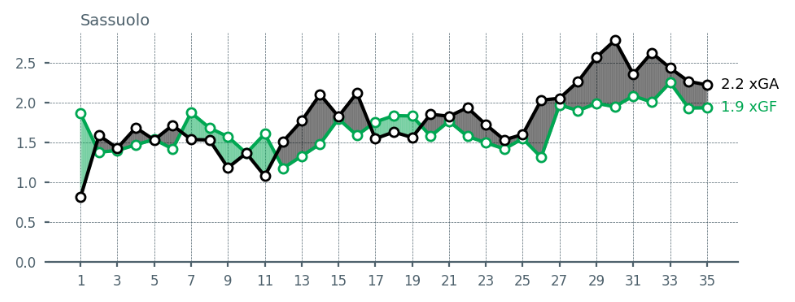
再設置更加豐富的顏色:
fig = plt.figure(figsize=(5, 8), dpi = 200, facecolor = "#EFE9E6") ax1 = plt.subplot(411, facecolor = "#EFE9E6") ax2 = plt.subplot(412, facecolor = "#EFE9E6") ax3 = plt.subplot(413, facecolor = "#EFE9E6") ax4 = plt.subplot(414, facecolor = "#EFE9E6") plot_xG_rolling("Sassuolo", ax1, color_for = "#00A752", color_ag = "black", data = df) plot_xG_rolling("Lazio", ax2, color_for = "#87D8F7", color_ag = "#15366F", data = df) plot_xG_rolling("Hellas Verona", ax3, color_for = "#153aab", color_ag = "#fdcf41", data = df) plot_xG_rolling("Empoli", ax4, color_for = "#00579C", color_ag = "black", data = df) plt.tight_layout()
